 Notes: Once the temporary station at Folkestone opened on 28 June 1843 work to complete Sir William Cubitt's 19-arch Foord viaduct progressed rapidly with the permanent station at Folkestone expected to be open by the late autumn. This was, however, delayed fallowing a serious landslip on the massive embankment between the station and the viaduct. The viaduct was finally completed on 20 November 1843 with the first locomotive running over it the following day with a series of trials taking place three weeks later. Notes: Once the temporary station at Folkestone opened on 28 June 1843 work to complete Sir William Cubitt's 19-arch Foord viaduct progressed rapidly with the permanent station at Folkestone expected to be open by the late autumn. This was, however, delayed fallowing a serious landslip on the massive embankment between the station and the viaduct. The viaduct was finally completed on 20 November 1843 with the first locomotive running over it the following day with a series of trials taking place three weeks later.
On 14 December a special train carried the SER's board of directors over the viaduct and into the new Folkestone station. On Monday 18 September the temporary station closed with trains being extended into the new terminus which was sited at the rear of the town on the east side.
 Folkestone station had two staggered platforms with passengers crossing the line on a boarded crossing; these were favoured by the SER although the Board of Trade considered them dangerous for passengers. Footbridges were eventually provided. A range of single-storey buildings was provided on both platforms with the main station entrance on the up side at the end of what later became Station Approach. A small timber signal box was later provided at the east end of the down platform; this replaced an earlier box at the junction with the line to Folkestone Harbour. Two back-to-back single-road brick engine sheds were built on the up side opposite the east end of the down platform; they opened on 18 December 1843. Folkestone station had two staggered platforms with passengers crossing the line on a boarded crossing; these were favoured by the SER although the Board of Trade considered them dangerous for passengers. Footbridges were eventually provided. A range of single-storey buildings was provided on both platforms with the main station entrance on the up side at the end of what later became Station Approach. A small timber signal box was later provided at the east end of the down platform; this replaced an earlier box at the junction with the line to Folkestone Harbour. Two back-to-back single-road brick engine sheds were built on the up side opposite the east end of the down platform; they opened on 18 December 1843.
The station had a small goods yard on the down side opposite the staggered up platform; this included a small through goods shed and a crane. A number of short sidings fanned out at right angles to the main line. These were connected to a turnplate with a line crossing the main line at right angles to another turnplate and a small two-road carriage shed on the up side.
 Extensive coke ovens were provided between the main line and the harbour branch. Early steam locomotives in the UK used coke as fuel, instead of coal, because of an early legal requirement that locomotives should 'consume their own smoke'. Coal produces smoke when burned whereas coke burns almost smoke-free. Coke is created by heating soft coal in an airtight oven. As it heats, the coal decomposes to give a hard, porous, greyish substance, and this coke contains almost 90% carbon. When it burns, coke produces intense, smokeless heat. Extensive coke ovens were provided between the main line and the harbour branch. Early steam locomotives in the UK used coke as fuel, instead of coal, because of an early legal requirement that locomotives should 'consume their own smoke'. Coal produces smoke when burned whereas coke burns almost smoke-free. Coke is created by heating soft coal in an airtight oven. As it heats, the coal decomposes to give a hard, porous, greyish substance, and this coke contains almost 90% carbon. When it burns, coke produces intense, smokeless heat.
Although the line had not yet reached the ferries at Dover - and passengers had to make the final leg of their journey in horse-drawn vehicles - the popularity of the new route far exceeded expectations. With the completion of SER's Folkestone Harbour, a ferry service between there and Boulogne was launched on 2 August 1843, and within five months of Folkestone station opening 20,000 people had made the crossing. Folkestone station was well laid out and popular with travellers, and every train was met by horse-drawn carriages ready to take passengers to Dover or Folkestone where steam ferries arrived and departed with every tide. This was a busy period for Folkestone station which now handled all traffic for the town and the harbour. The station was served by eight trains a day in each direction with the fastest journey time to London taking 3 hours and 5 minutes at an average speed of 29.6 mph.
 To the north of the station the SER built a branch line to the harbour, but this had no direct connection with the main line. Instead it trailed into exchange sidings close to the station requiring a reversal in order to reach the main line. This was a safety requirement as the steeply-graded harbour branch descended at 1 in 30 for three quarters of a mile. While the Folkestone Harbour branch would be restricted to goods traffic until 1849 the extension to Dover was quickly completed, and on 7 February 1844 Folkestone was no longer a terminus when the first public train left the station bound for Dover. To the north of the station the SER built a branch line to the harbour, but this had no direct connection with the main line. Instead it trailed into exchange sidings close to the station requiring a reversal in order to reach the main line. This was a safety requirement as the steeply-graded harbour branch descended at 1 in 30 for three quarters of a mile. While the Folkestone Harbour branch would be restricted to goods traffic until 1849 the extension to Dover was quickly completed, and on 7 February 1844 Folkestone was no longer a terminus when the first public train left the station bound for Dover.
It had always been the intention of the SER to concentrate its ferry services on Folkestone rather than Dover. April 1848 saw the opening of the Boulogne & Amiens Railway which made the completion of the Folkestone Harbour branch imperative. Once numerous improvements required by the Board of Trade had been completed, the branch finally opened to the public as far as the pier on 1 January 1849; at this time passengers still had to walk across the swing bridge to reach the ferries. They also had to change trains at Folkestone for the short journey to the Harbour but, not surprisingly, this was unpopular. In July 1849 Folkestone station was renamed Folkestone Old. Two years after the Folkestone Harbour branch opened the name was once again changed to Folkestone Junction in January 1850.
With the opening of the station at Folkestone Harbour, Folkestone Junction lost much of its traffic: not only the boat train traffic but some of the town traffic as well. This was further eroded with the opening of Shorncliffe Camp station on the west side of the town on 1 November 1863.

In 1884 the London Chatham & Dover Railway (LC&DR), the arch rival of the SER, was determined to reach Folkestone, reviving an earlier proposal to build a double-track line along the Alkham Valley from Kearsney, on its Canterbury to Dover line, to a new terminus at Folkestone from where it hoped to reach London by paralleling the SER. A Bill was prepared to put before Parliament in 1884. In an attempt to block this new, financially damaging route, the SER revived its Elham Valley line. The SER was anxious secure the goodwill of the people of Folkestone. Folkestone Junction station was inconveniently located on the east side of the town so when the SER received a request for a more centrally sited station, the SER chairman Sir Edward Watkin gave his personal assurance that the request would be investigated.
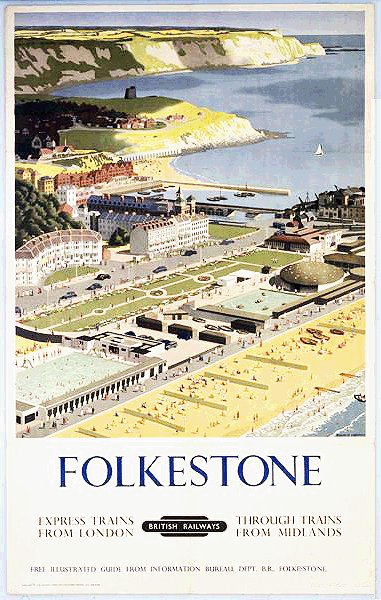 The SER was keen to win local support in an attempt to block the LD&DR. Although the Alkham Valley scheme was eventually dropped and the Elham Valley line was built, Folkestone did receive its central station. A site was quickly chosen on the west of Cheriton Road and construction began immediately and progressed rapidly. The planned name was Cheriton Road but when the station opened on 18 August 1884 it was called Cheriton Arch after the narrow brick arch that carried the railway over the road. In September 1886 the name was changed to Radnor Park at a time when a large area of adjacent land had been gifted to the town by Lord Radnor. The station became Folkestone Central on 1 June 1895. The SER was keen to win local support in an attempt to block the LD&DR. Although the Alkham Valley scheme was eventually dropped and the Elham Valley line was built, Folkestone did receive its central station. A site was quickly chosen on the west of Cheriton Road and construction began immediately and progressed rapidly. The planned name was Cheriton Road but when the station opened on 18 August 1884 it was called Cheriton Arch after the narrow brick arch that carried the railway over the road. In September 1886 the name was changed to Radnor Park at a time when a large area of adjacent land had been gifted to the town by Lord Radnor. The station became Folkestone Central on 1 June 1895.
Folkestone Central was soon the principal passenger station for the town with goods traffic being concentrated at Folkestone Junction. Extensive new goods facilities were provided there on the site of the old coking ovens. These had been taken out of use in the 1880s once coal-burning had been perfected. A private siding on the up side, immediately north of the junction with the harbour branch, served a canning manufactory. By the first decade of the twentieth century the same siding served a corporation depot with a refuse destructor. In 1900 a new 3-road engine shed with a water tank on a brick base to the rear was provided on the down side behind the signal box; the two earlier sheds were closed at the same time. A number of locomotives were kept here primarily for help with the 1 in 30 incline on the harbour branch. A 65ft turntable was added alongside the shed in 1918.
At the turn of the century the scene at Folkestone junction was one of incessant activity. The Harbour branch remained busy with the passenger and goods trains which had to be hauled up the tortuous incline to the exchange sidings. In 1908 the small wooden signal box at the east end of the down platform at Folkestone Junction was replaced with a much larger box on a brick base.
 The 1907 Ordnance Survey map (reproduced below) shows goods facilities on both sides of the line. The main goods yard which comprised a long through goods shed, cattle dock and pens and a coal depot was located to the south of the station between the main line and the harbour branch. The original goods yard was retained with further sidings, a second goods shed and a 4-ton capacity crane on the down side opposite the staggered up platform. The exchange sidings for the harbour branch were provided between the south side yard and the up line. The 1907 Ordnance Survey map (reproduced below) shows goods facilities on both sides of the line. The main goods yard which comprised a long through goods shed, cattle dock and pens and a coal depot was located to the south of the station between the main line and the harbour branch. The original goods yard was retained with further sidings, a second goods shed and a 4-ton capacity crane on the down side opposite the staggered up platform. The exchange sidings for the harbour branch were provided between the south side yard and the up line.
During WW1, a landslide on 19 December 1915 resulted in the entire undercliff supporting the main line at Folkestone Warren moving towards the sea blocking a mile of track between the Martello and Abbotscliffe tunnels. After consultation with the Board of Trade the SE&CR decided that the blockage could not be removed during the War. The Junction station once again became a terminus. The reopening of the railway between Dover and Folkestone took place on 11 August 1919, the line having been reconstructed during the spring and early summer. At this time a new signal box was opened at Folkestone Junction on the up side of the Dover end of Martello tunnel. This became Folkestone B with the earlier box now known as Folkestone A.
After the grouping on 1 January 1923, Folkestone Junction came under the control of the Southern Railway and the station was painted in the smart dark green, buff and white of the new company, whilst a vivid and colourful array of posters covered the walls, advertising tempting holidays in Britain to places as far away as Scotland, Devon and Cornwall.
On 22 June 1930 Folkestone Junction B signal box was closed after only 11 years’ service, with control of its four signals being transferred to the A box.
During WW2, a number of high explosive bombs fell near the junction station, but damage was limited to nearby houses.
 In 1960 both platforms were extended at opposite ends as part of Stage 2 of the Kent Coast Electrification which included both the main line and the harbour branch. For the first time the two platforms faced each other. Colour light signalling was also installed and a new signal box was provided at the rear of the down platform controlling movements between Ashford and Dover Archcliffe Junction. Folkestone shed closed on 12 June 1961 following electrification. In September 1962 Shorncliffe was renamed Folkestone West, whilst the junction station became Folkestone East. In the late 1950s British Rail (Southern Region) installed totem signage at Folkestone Junction, one version of the signs (reading Folkestone ‘Jct’) being proficiently painted over totems from Kenley (Surrey). New signs were installed when the station became Folkestone East, but the re-signing, the recent platform construction and the earlier platform extensions seemed an extravagance as the station closed on 6 September 1965. The down platform and buildings were quickly demolished, although a short section of platform was retained for railway staff at the signal box; this is still in use but the Folkestone East box is due to be abolished in 2018 with control of the area passing to the South Kent Regional Operations Centre at Ashford. The up platform building lingered until 1978 and the platform is extant. In 1960 both platforms were extended at opposite ends as part of Stage 2 of the Kent Coast Electrification which included both the main line and the harbour branch. For the first time the two platforms faced each other. Colour light signalling was also installed and a new signal box was provided at the rear of the down platform controlling movements between Ashford and Dover Archcliffe Junction. Folkestone shed closed on 12 June 1961 following electrification. In September 1962 Shorncliffe was renamed Folkestone West, whilst the junction station became Folkestone East. In the late 1950s British Rail (Southern Region) installed totem signage at Folkestone Junction, one version of the signs (reading Folkestone ‘Jct’) being proficiently painted over totems from Kenley (Surrey). New signs were installed when the station became Folkestone East, but the re-signing, the recent platform construction and the earlier platform extensions seemed an extravagance as the station closed on 6 September 1965. The down platform and buildings were quickly demolished, although a short section of platform was retained for railway staff at the signal box; this is still in use but the Folkestone East box is due to be abolished in 2018 with control of the area passing to the South Kent Regional Operations Centre at Ashford. The up platform building lingered until 1978 and the platform is extant.
Part of the goods yard was later used by a new road called Southern Way and more recently part of the yard has been used to site of an underground pumping station for Southern Water. Various schemes for the re-use of the remaining land at Folkestone East have been proposed, from the site of a new depot, sidings for stabling and maintaining CTRL services. The site of the former goods yard was offered for sale in January 2008 and today most of the land is still awaiting development.
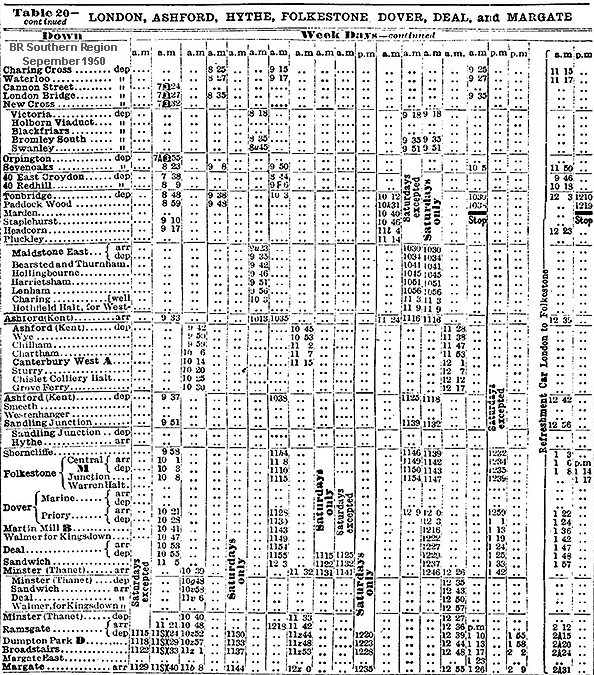
Over the years there have been numerous proposals to reopen the station. Most recently Shepway Green Party has launched a campaign to reinstate Folkestone East, insisting it would be a major boost for the area’s regeneration plans. The scheme has been given approval by the Remembrance Line Association which is hoping to operate a tram service connecting the harbour to the town centre, partly using the old harbour branch line. The association claims that a reopened East station could regain its status as the principal station for the town because of insufficient car par parking space at Folkestone Central.
BRIEF HISTORY OF THE FOLKESTONE - DOVER LINE
The first proposal for a railway between Dover and London was made in May 1834. On 21 June 1836, Parliament passed an Act incorporating the South Eastern & Dover Railway, which shortly afterwards became the South Eastern Railway. The new company was formed to construct the line from London to Dover.
 The engineer of the Dover line was William Cubitt who was also engineer of the London & Croydon Railway. The chosen route, which passed over the lines of three other companies, would start at London Bridge, from where it would use London & Greenwich metals as far as Southwark and then turn south towards Croydon. From a junction with the London & Croydon at Norwood the Dover line would then share the London & Brighton main line to Redhill where it would turn east towards Tonbridge, Ashford and Folkestone. Construction began in 1838 at several places simultaneously. The L&BR line to Redhill opened on 12 July 1841. The line between Redhill and Ashford was almost straight with few engineering difficulties. The SER line from Redhill to Tonbridge opened on 26 May 1842, when SER train services began. The line reached Ashford on 1 December 1842 and the outskirts of Folkestone by 28 June 1843. The engineer of the Dover line was William Cubitt who was also engineer of the London & Croydon Railway. The chosen route, which passed over the lines of three other companies, would start at London Bridge, from where it would use London & Greenwich metals as far as Southwark and then turn south towards Croydon. From a junction with the London & Croydon at Norwood the Dover line would then share the London & Brighton main line to Redhill where it would turn east towards Tonbridge, Ashford and Folkestone. Construction began in 1838 at several places simultaneously. The L&BR line to Redhill opened on 12 July 1841. The line between Redhill and Ashford was almost straight with few engineering difficulties. The SER line from Redhill to Tonbridge opened on 26 May 1842, when SER train services began. The line reached Ashford on 1 December 1842 and the outskirts of Folkestone by 28 June 1843.
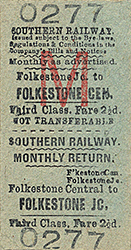 The route between Folkestone and Dover took the line between the cliff and the sea and a number of major engineering difficulties had to be overcome. It was for this reason that the company bought Folkestone Harbour and turned it into their port of choice for cross-channel ferries. One of the major natural obstacles was the Round Down cliff; the SER's solution was to blow it up! Four tunnels were also required: these were Martello Tunnel (530 yd) at the western end, then Abbotscliffe Tunnel (1 mile 182yd), Shakespeare’s Cliff Tunnel (1392 yd) and finally Archcliffe Tunnel (50 yards - opened out in 1927) at the eastern end near Dover. The Martello tunnel was driven through Gault Clay and Greensand and was more difficult to construct than the other three. Martello and Abbotscliffe are both double-track tunnels. Because of the instability of the Chalk, Shakespeare’s Cliff Tunnel comprised two single-track bores of unusual design. They are very tall, the crown being 28ft above track level, and have Gothic cross-section. Both Shakespeare’s Cliff and Abbotscliffe tunnels are close to the cliff face, so were constructed using horizontal access shafts, as well as the more normal vertical ones. Rubble was taken through the horizontal shafts to be transferred to boats for disposal. Archcliffe Tunnel comprised two short, single bores, passing below Archcliffe Fort on the outskirts of Dover. The route between Folkestone and Dover took the line between the cliff and the sea and a number of major engineering difficulties had to be overcome. It was for this reason that the company bought Folkestone Harbour and turned it into their port of choice for cross-channel ferries. One of the major natural obstacles was the Round Down cliff; the SER's solution was to blow it up! Four tunnels were also required: these were Martello Tunnel (530 yd) at the western end, then Abbotscliffe Tunnel (1 mile 182yd), Shakespeare’s Cliff Tunnel (1392 yd) and finally Archcliffe Tunnel (50 yards - opened out in 1927) at the eastern end near Dover. The Martello tunnel was driven through Gault Clay and Greensand and was more difficult to construct than the other three. Martello and Abbotscliffe are both double-track tunnels. Because of the instability of the Chalk, Shakespeare’s Cliff Tunnel comprised two single-track bores of unusual design. They are very tall, the crown being 28ft above track level, and have Gothic cross-section. Both Shakespeare’s Cliff and Abbotscliffe tunnels are close to the cliff face, so were constructed using horizontal access shafts, as well as the more normal vertical ones. Rubble was taken through the horizontal shafts to be transferred to boats for disposal. Archcliffe Tunnel comprised two short, single bores, passing below Archcliffe Fort on the outskirts of Dover.

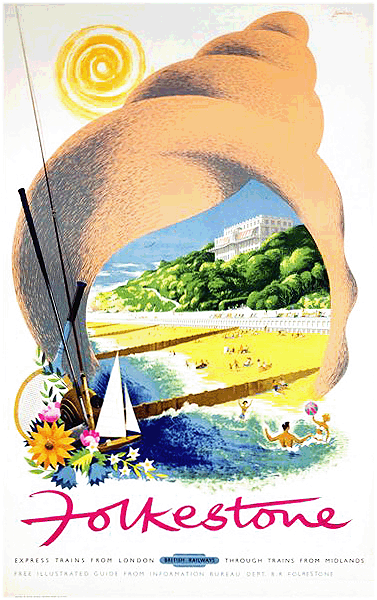 The line eventually reached Dover on 27 January 1844. Following the official opening on 6 February the passenger service between London and Dover Town began the following day. Six trains per day were provided in each direction. The line eventually reached Dover on 27 January 1844. Following the official opening on 6 February the passenger service between London and Dover Town began the following day. Six trains per day were provided in each direction.
Initially the SER showed interest in attracting tourists to Dover by offering excursion fares. They also introduced ships from Dover to Ostend; but the company’s major interest was the promotion of Folkestone Harbour.
One of the problems that SER constantly faced was that from Folkestone to Dover the tracks were – and still are – so close to the cliffs and sea. The area is known to have been liable to extensive landslips, the first recorded slip having taken place in 1765. On 14 November 1875 there was a severe storm that wrecked groynes and severely damaged the Town station roof, and the track was flooded. Two years later the line was closed for two months due to a 60,000 ton landslide, and it was mooted that SER would not reopen it. Sir Edward Watkin, SER chairman, blamed the rumour on his adversaries at LCDR. He visited the scene of devastation and later arranged for an official reopening after three months’ closure. On Sunday 20 March 1881 the line was again buried under about 20ft of chalk, just west of Abbotscliffe. Eight landslips were recorded before the turn of the twentieth century.
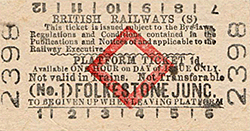 On 19 December 1915, a landslide resulted in the entire undercliff supporting the main line moving towards the sea causing approximately 1.9 million cubic yards of chalk to slip or fall completely; the incident blocked a mile of track between the Martello and Abbotscliffe tunnels. The movement occurred over the whole length of the Warren and several cliffs collapsed resulting in the chalk fluidising and burying the rail lines with up to 65ft of debris and creating a flow 230ft out to sea. The maximum displacement was about 165ft near the centre of the disturbance. On 19 December 1915, a landslide resulted in the entire undercliff supporting the main line moving towards the sea causing approximately 1.9 million cubic yards of chalk to slip or fall completely; the incident blocked a mile of track between the Martello and Abbotscliffe tunnels. The movement occurred over the whole length of the Warren and several cliffs collapsed resulting in the chalk fluidising and burying the rail lines with up to 65ft of debris and creating a flow 230ft out to sea. The maximum displacement was about 165ft near the centre of the disturbance.
Soldiers stationed in the signal box managed to slow the 6.10pm Ashford to Dover service at the mouth of the Martello Tunnel and, although the train came to a halt partly on the landslide derailing some of the coaches, the passengers and crew were able to walk back to Folkestone Junction along the beach and no one was injured. This was one of the largest landslides in Kent.
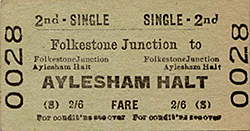 After consultation with the Board of Trade the SECR decided that the blockage could not be removed during the War. Thus, passengers who wished to travel from Folkestone to Dover were faced with a long, arduous journey as Dover was under military rule and they could not enter the town except by rail. Thus they had to leave Folkestone on the Elham Valley Line to Canterbury then head back to Dover on the old LCDR line. For the remainder of the War the Admiralty used the tunnels to store mines and shells for locally based warships. During the four-year closure, drainage adits were bored from beach level up through the complex in an attempt to halt further coastal erosion, but small landslips continued to occur periodically. After consultation with the Board of Trade the SECR decided that the blockage could not be removed during the War. Thus, passengers who wished to travel from Folkestone to Dover were faced with a long, arduous journey as Dover was under military rule and they could not enter the town except by rail. Thus they had to leave Folkestone on the Elham Valley Line to Canterbury then head back to Dover on the old LCDR line. For the remainder of the War the Admiralty used the tunnels to store mines and shells for locally based warships. During the four-year closure, drainage adits were bored from beach level up through the complex in an attempt to halt further coastal erosion, but small landslips continued to occur periodically.
The reopening of the railway between Dover and Folkestone took place on 11 August 1919, the line having been reconstructed during the spring and early summer. SECR became part of Southern Railway that came into operation on 1 January 1923.
Tickets from Michael Stewart. Route map drawn by Alan Young. Bradshaw from Chris Hind. Totems from Richard Furness.
Click here to see a film of a train journey between Folkestone Junction and Dover Priory in the 1920s including a view of Folkestone Warren Halt.
Click here to see a 7 minute film of a return journey from Folkestone East to Folkestone Harbouron on 14 June 2007 by Chris Fletcher . Includes a good view of the staff halt at Folkestone East.
Sources:
See also: Folkestone (temporary station), Folkestone Harbour, Folkestone Warren Halt, Shakespeare Cliff Halt,
Dover Town, Archcliffe Junction Staff Halt, Dover Admiralty Pier, Dover Prince of Wales Pier, Dover Marine/Western Docks
& Dover Harbour
see also:
Detailed history of Shakespeare Colliery with many photos.
Detailed history of the first Channel Tunnel attempt in 1880 |

east_old6.jpg)

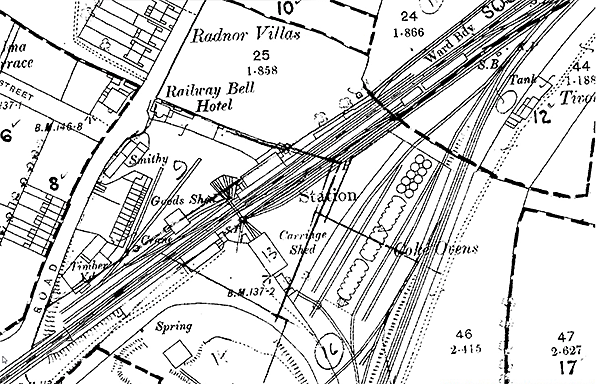
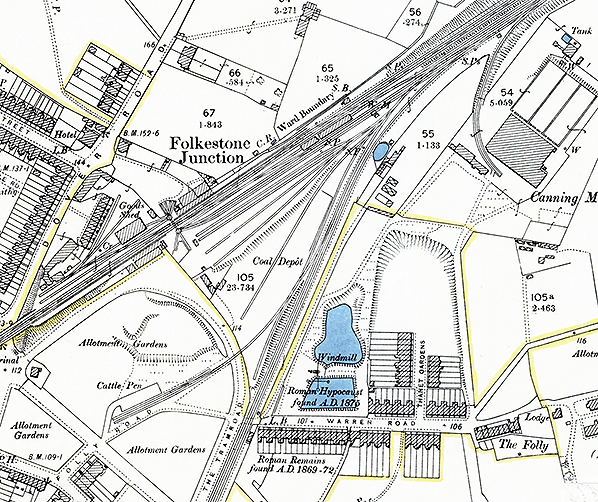
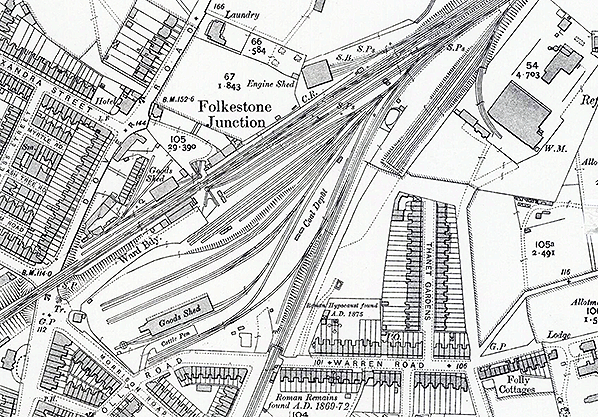
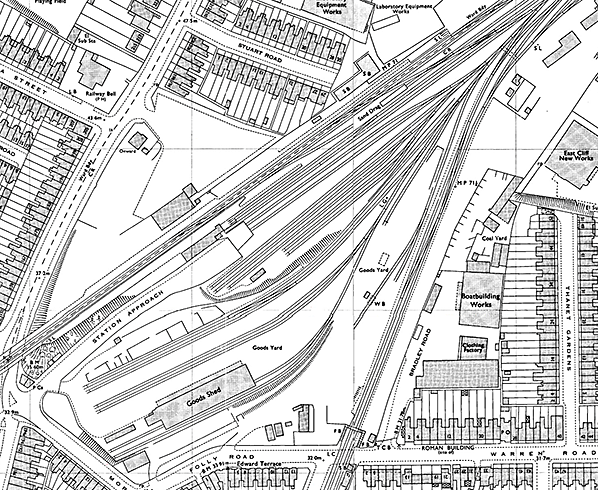
east_old4.jpg)
east_old3.jpg)
east_old5.jpg)
east_old16.jpg)
east_old10.jpg)
east_old11.jpg)

 Notes: Once the temporary station at Folkestone opened on 28 June 1843 work to complete Sir William Cubitt's 19-arch Foord viaduct progressed rapidly with the permanent station at Folkestone expected to be open by the late autumn. This was, however, delayed fallowing a serious landslip on the massive embankment between the station and the viaduct. The viaduct was finally completed on 20 November 1843 with the first locomotive running over it the following day with a series of trials taking place three weeks later.
Notes: Once the temporary station at Folkestone opened on 28 June 1843 work to complete Sir William Cubitt's 19-arch Foord viaduct progressed rapidly with the permanent station at Folkestone expected to be open by the late autumn. This was, however, delayed fallowing a serious landslip on the massive embankment between the station and the viaduct. The viaduct was finally completed on 20 November 1843 with the first locomotive running over it the following day with a series of trials taking place three weeks later.  Folkestone station had two staggered platforms with passengers crossing the line on a boarded crossing; these were favoured by the SER although the Board of Trade considered them dangerous for passengers. Footbridges were eventually provided. A range of single-storey buildings was provided on both platforms with the main station entrance on the up side at the end of what later became Station Approach. A small timber signal box was later provided at the east end of the down platform; this replaced an earlier box at the junction with the line to Folkestone Harbour. Two back-to-back single-road brick engine sheds were built on the up side opposite the east end of the down platform; they opened on 18 December 1843.
Folkestone station had two staggered platforms with passengers crossing the line on a boarded crossing; these were favoured by the SER although the Board of Trade considered them dangerous for passengers. Footbridges were eventually provided. A range of single-storey buildings was provided on both platforms with the main station entrance on the up side at the end of what later became Station Approach. A small timber signal box was later provided at the east end of the down platform; this replaced an earlier box at the junction with the line to Folkestone Harbour. Two back-to-back single-road brick engine sheds were built on the up side opposite the east end of the down platform; they opened on 18 December 1843. Extensive coke ovens were provided between the main line and the harbour branch. Early steam locomotives in the UK used coke as fuel, instead of coal, because of an early legal requirement that locomotives should 'consume their own smoke'. Coal produces smoke when burned whereas coke burns almost smoke-free. Coke is created by heating soft coal in an airtight oven. As it heats, the coal decomposes to give a hard, porous, greyish substance, and this coke contains almost 90% carbon. When it burns, coke produces intense, smokeless heat.
Extensive coke ovens were provided between the main line and the harbour branch. Early steam locomotives in the UK used coke as fuel, instead of coal, because of an early legal requirement that locomotives should 'consume their own smoke'. Coal produces smoke when burned whereas coke burns almost smoke-free. Coke is created by heating soft coal in an airtight oven. As it heats, the coal decomposes to give a hard, porous, greyish substance, and this coke contains almost 90% carbon. When it burns, coke produces intense, smokeless heat. To the north of the station the SER built a branch line to the harbour, but this had no direct connection with the main line. Instead it trailed into exchange sidings close to the station requiring a reversal in order to reach the main line. This was a safety requirement as the steeply-graded harbour branch descended at 1 in 30 for three quarters of a mile. While the Folkestone Harbour branch would be restricted to goods traffic until 1849 the extension to Dover was quickly completed, and on 7 February 1844 Folkestone was no longer a terminus when the first public train left the station bound for Dover.
To the north of the station the SER built a branch line to the harbour, but this had no direct connection with the main line. Instead it trailed into exchange sidings close to the station requiring a reversal in order to reach the main line. This was a safety requirement as the steeply-graded harbour branch descended at 1 in 30 for three quarters of a mile. While the Folkestone Harbour branch would be restricted to goods traffic until 1849 the extension to Dover was quickly completed, and on 7 February 1844 Folkestone was no longer a terminus when the first public train left the station bound for Dover.
 The SER was keen to win local support in an attempt to block the LD&DR. Although the Alkham Valley scheme was eventually dropped and the Elham Valley line was built, Folkestone did receive its central station. A site was quickly chosen on the west of Cheriton Road and construction began immediately and progressed rapidly. The planned name was Cheriton Road but when the station opened on 18 August 1884 it was called Cheriton Arch after the narrow brick arch that carried the railway over the road. In September 1886 the name was changed to Radnor Park at a time when a large area of adjacent land had been gifted to the town by Lord Radnor. The station became Folkestone Central on 1 June 1895.
The SER was keen to win local support in an attempt to block the LD&DR. Although the Alkham Valley scheme was eventually dropped and the Elham Valley line was built, Folkestone did receive its central station. A site was quickly chosen on the west of Cheriton Road and construction began immediately and progressed rapidly. The planned name was Cheriton Road but when the station opened on 18 August 1884 it was called Cheriton Arch after the narrow brick arch that carried the railway over the road. In September 1886 the name was changed to Radnor Park at a time when a large area of adjacent land had been gifted to the town by Lord Radnor. The station became Folkestone Central on 1 June 1895. The 1907 Ordnance Survey map (reproduced below) shows goods facilities on both sides of the line. The main goods yard which comprised a long through goods shed, cattle dock and pens and a coal depot was located to the south of the station between the main line and the harbour branch. The original goods yard was retained with further sidings, a second goods shed and a 4-ton capacity crane on the down side opposite the staggered up platform. The exchange sidings for the harbour branch were provided between the south side yard and the up line.
The 1907 Ordnance Survey map (reproduced below) shows goods facilities on both sides of the line. The main goods yard which comprised a long through goods shed, cattle dock and pens and a coal depot was located to the south of the station between the main line and the harbour branch. The original goods yard was retained with further sidings, a second goods shed and a 4-ton capacity crane on the down side opposite the staggered up platform. The exchange sidings for the harbour branch were provided between the south side yard and the up line. In 1960 both platforms were extended at opposite ends as part of Stage 2 of the Kent Coast Electrification which included both the main line and the harbour branch. For the first time the two platforms faced each other. Colour light signalling was also installed and a new signal box was provided at the rear of the down platform controlling movements between Ashford and Dover Archcliffe Junction. Folkestone shed closed on 12 June 1961 following electrification. In September 1962 Shorncliffe was renamed Folkestone West, whilst the junction station became Folkestone East. In the late 1950s British Rail (Southern Region) installed totem signage at Folkestone Junction, one version of the signs (reading Folkestone ‘Jct’) being proficiently painted over totems from Kenley (Surrey). New signs were installed when the station became Folkestone East, but the re-signing, the recent platform construction and the earlier platform extensions seemed an extravagance as the station closed on 6 September 1965. The down platform and buildings were quickly demolished, although a short section of platform was retained for railway staff at the signal box; this is still in use but the Folkestone East box is due to be abolished in 2018 with control of the area passing to the South Kent Regional Operations Centre at Ashford. The up platform building lingered until 1978 and the platform is extant.
In 1960 both platforms were extended at opposite ends as part of Stage 2 of the Kent Coast Electrification which included both the main line and the harbour branch. For the first time the two platforms faced each other. Colour light signalling was also installed and a new signal box was provided at the rear of the down platform controlling movements between Ashford and Dover Archcliffe Junction. Folkestone shed closed on 12 June 1961 following electrification. In September 1962 Shorncliffe was renamed Folkestone West, whilst the junction station became Folkestone East. In the late 1950s British Rail (Southern Region) installed totem signage at Folkestone Junction, one version of the signs (reading Folkestone ‘Jct’) being proficiently painted over totems from Kenley (Surrey). New signs were installed when the station became Folkestone East, but the re-signing, the recent platform construction and the earlier platform extensions seemed an extravagance as the station closed on 6 September 1965. The down platform and buildings were quickly demolished, although a short section of platform was retained for railway staff at the signal box; this is still in use but the Folkestone East box is due to be abolished in 2018 with control of the area passing to the South Kent Regional Operations Centre at Ashford. The up platform building lingered until 1978 and the platform is extant. 
 The engineer of the Dover line was William Cubitt who was also engineer of the London & Croydon Railway. The chosen route, which passed over the lines of three other companies, would start at London Bridge, from where it would use London & Greenwich metals as far as Southwark and then turn south towards Croydon. From a junction with the London & Croydon at Norwood the Dover line would then share the London & Brighton main line to Redhill where it would turn east towards Tonbridge, Ashford and Folkestone. Construction began in 1838 at several places simultaneously. The L&BR line to Redhill opened on 12 July 1841. The line between Redhill and Ashford was almost straight with few engineering difficulties. The SER line from Redhill to Tonbridge opened on 26 May 1842, when SER train services began. The line reached Ashford on 1 December 1842 and the outskirts of Folkestone by 28 June 1843.
The engineer of the Dover line was William Cubitt who was also engineer of the London & Croydon Railway. The chosen route, which passed over the lines of three other companies, would start at London Bridge, from where it would use London & Greenwich metals as far as Southwark and then turn south towards Croydon. From a junction with the London & Croydon at Norwood the Dover line would then share the London & Brighton main line to Redhill where it would turn east towards Tonbridge, Ashford and Folkestone. Construction began in 1838 at several places simultaneously. The L&BR line to Redhill opened on 12 July 1841. The line between Redhill and Ashford was almost straight with few engineering difficulties. The SER line from Redhill to Tonbridge opened on 26 May 1842, when SER train services began. The line reached Ashford on 1 December 1842 and the outskirts of Folkestone by 28 June 1843. The route between Folkestone and Dover took the line between the cliff and the sea and a number of major engineering difficulties had to be overcome. It was for this reason that the company bought Folkestone Harbour and turned it into their port of choice for cross-channel ferries. One of the major natural obstacles was the Round Down cliff; the SER's solution was to blow it up! Four tunnels were also required: these were Martello Tunnel (530 yd) at the western end, then Abbotscliffe Tunnel (1 mile 182yd), Shakespeare’s Cliff Tunnel (1392 yd) and finally Archcliffe Tunnel (50 yards - opened out in 1927) at the eastern end near Dover. The Martello tunnel was driven through Gault Clay and Greensand and was more difficult to construct than the other three. Martello and Abbotscliffe are both double-track tunnels. Because of the instability of the Chalk, Shakespeare’s Cliff Tunnel comprised two single-track bores of unusual design. They are very tall, the crown being 28ft above track level, and have Gothic cross-section. Both Shakespeare’s Cliff and Abbotscliffe tunnels are close to the cliff face, so were constructed using horizontal access shafts, as well as the more normal vertical ones. Rubble was taken through the horizontal shafts to be transferred to boats for disposal. Archcliffe Tunnel comprised two short, single bores, passing below Archcliffe Fort on the outskirts of Dover.
The route between Folkestone and Dover took the line between the cliff and the sea and a number of major engineering difficulties had to be overcome. It was for this reason that the company bought Folkestone Harbour and turned it into their port of choice for cross-channel ferries. One of the major natural obstacles was the Round Down cliff; the SER's solution was to blow it up! Four tunnels were also required: these were Martello Tunnel (530 yd) at the western end, then Abbotscliffe Tunnel (1 mile 182yd), Shakespeare’s Cliff Tunnel (1392 yd) and finally Archcliffe Tunnel (50 yards - opened out in 1927) at the eastern end near Dover. The Martello tunnel was driven through Gault Clay and Greensand and was more difficult to construct than the other three. Martello and Abbotscliffe are both double-track tunnels. Because of the instability of the Chalk, Shakespeare’s Cliff Tunnel comprised two single-track bores of unusual design. They are very tall, the crown being 28ft above track level, and have Gothic cross-section. Both Shakespeare’s Cliff and Abbotscliffe tunnels are close to the cliff face, so were constructed using horizontal access shafts, as well as the more normal vertical ones. Rubble was taken through the horizontal shafts to be transferred to boats for disposal. Archcliffe Tunnel comprised two short, single bores, passing below Archcliffe Fort on the outskirts of Dover.
 The line eventually reached Dover on 27 January 1844. Following the official opening on 6 February the passenger service between London and Dover Town began the following day. Six trains per day were provided in each direction.
The line eventually reached Dover on 27 January 1844. Following the official opening on 6 February the passenger service between London and Dover Town began the following day. Six trains per day were provided in each direction.  On 19 December 1915, a landslide resulted in the entire undercliff supporting the main line moving towards the sea causing approximately 1.9 million cubic yards of chalk to slip or fall completely; the incident blocked a mile of track between the Martello and Abbotscliffe tunnels. The movement occurred over the whole length of the Warren and several cliffs collapsed resulting in the chalk fluidising and burying the rail lines with up to 65ft of debris and creating a flow 230ft out to sea. The maximum displacement was about 165ft near the centre of the disturbance.
On 19 December 1915, a landslide resulted in the entire undercliff supporting the main line moving towards the sea causing approximately 1.9 million cubic yards of chalk to slip or fall completely; the incident blocked a mile of track between the Martello and Abbotscliffe tunnels. The movement occurred over the whole length of the Warren and several cliffs collapsed resulting in the chalk fluidising and burying the rail lines with up to 65ft of debris and creating a flow 230ft out to sea. The maximum displacement was about 165ft near the centre of the disturbance. After consultation with the Board of Trade the SECR decided that the blockage could not be removed during the War. Thus, passengers who wished to travel from Folkestone to Dover were faced with a long, arduous journey as Dover was under military rule and they could not enter the town except by rail. Thus they had to leave Folkestone on the Elham Valley Line to Canterbury then head back to Dover on the old LCDR line. For the remainder of the War the Admiralty used the tunnels to store mines and shells for locally based warships. During the four-year closure, drainage adits were bored from beach level up through the complex in an attempt to halt further coastal erosion, but small landslips continued to occur periodically.
After consultation with the Board of Trade the SECR decided that the blockage could not be removed during the War. Thus, passengers who wished to travel from Folkestone to Dover were faced with a long, arduous journey as Dover was under military rule and they could not enter the town except by rail. Thus they had to leave Folkestone on the Elham Valley Line to Canterbury then head back to Dover on the old LCDR line. For the remainder of the War the Admiralty used the tunnels to store mines and shells for locally based warships. During the four-year closure, drainage adits were bored from beach level up through the complex in an attempt to halt further coastal erosion, but small landslips continued to occur periodically.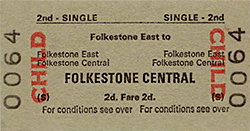
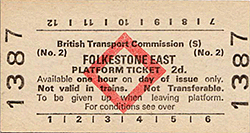

 Home Page
Home Page